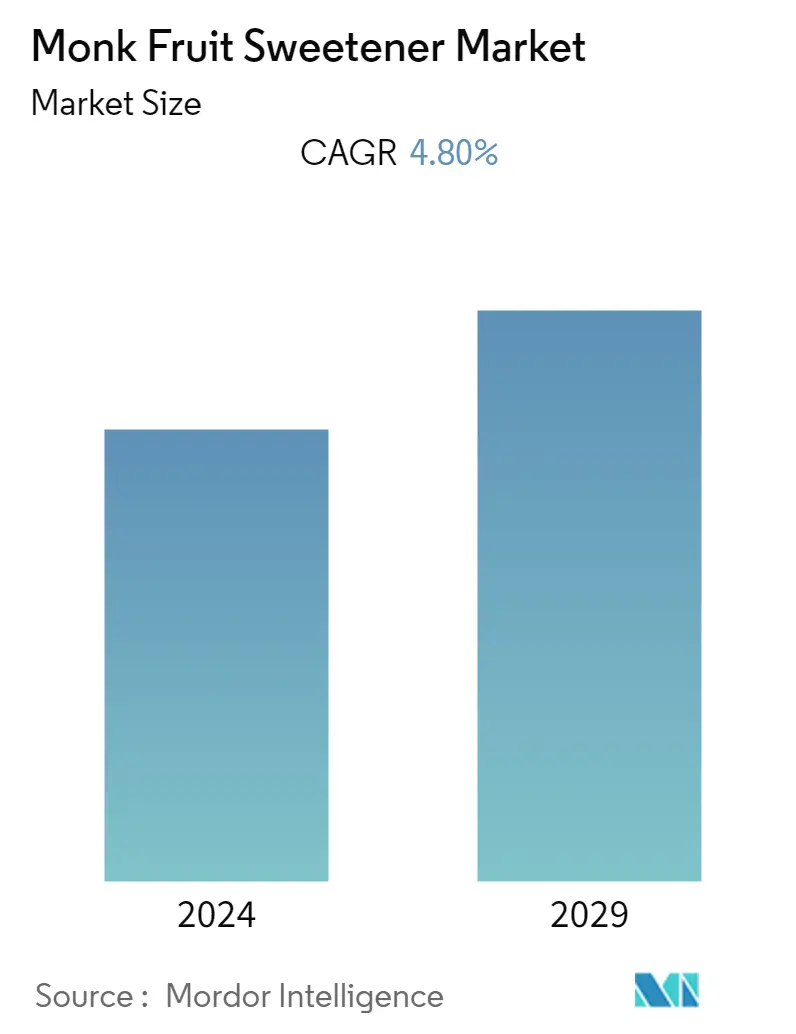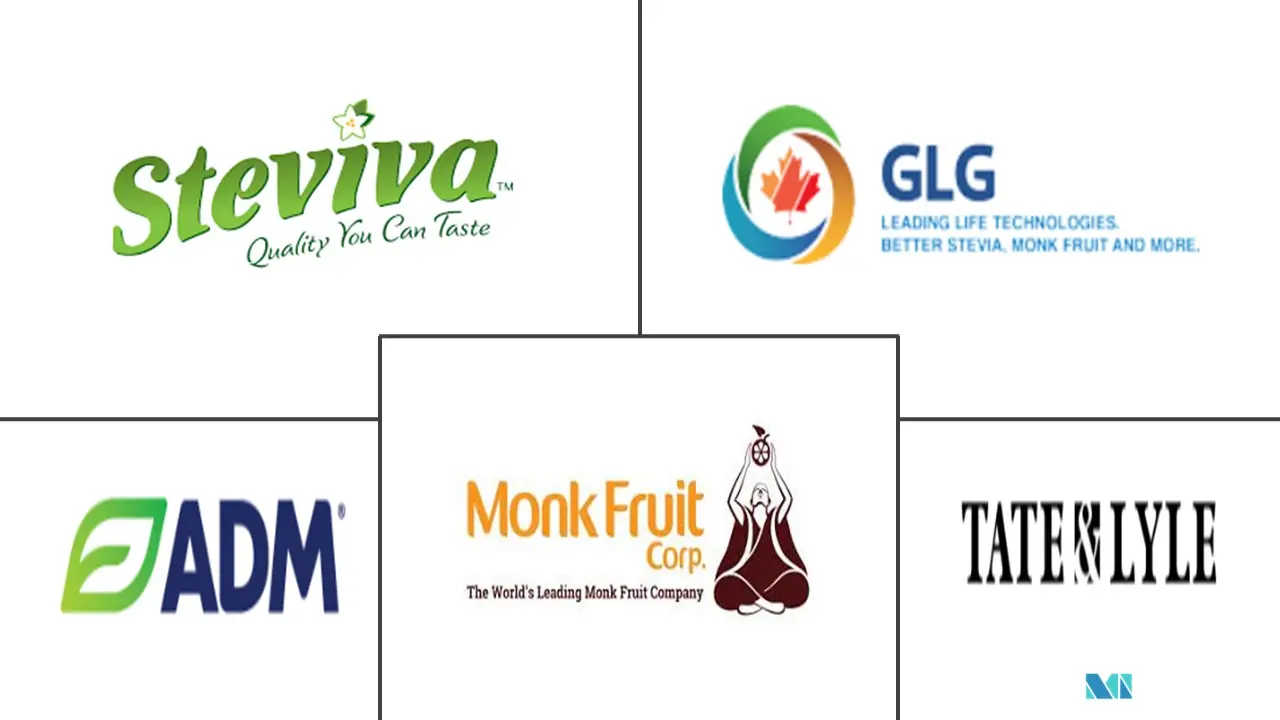Market Size of Monk Fruit Sweetener Industry

| Study Period | 2019 - 2029 |
| Base Year For Estimation | 2023 |
| CAGR | 4.80 % |
| Fastest Growing Market | Asia Pacific |
| Largest Market | North America |
| Market Concentration | Low |
Major Players
*Disclaimer: Major Players sorted in no particular order |
Monk Fruit Sweetener Market Analysis
The global monk fruit sweeteners market is projected to register a CAGR of 4.8% over the next five years.
- The rising health consciousness among consumers is placing additional demand for naturally derived sweeteners. The negative health effects of sugar, especially in diabetic patients, and the rise in diabetic incidences are bound to support the market demand.
- Monk fruit sweeteners contain added functional properties such as anti-inflammatory, anti-microbial, and anti-carcinogenic properties, providing additional medicinal value to consumers. Consumers are making healthier food choices, and the market is witnessing a shift in consumer attitudes toward sugar and other sugar products. The preference towards low-calorie or zero-calorie sugar products by consumers across the globe is aiding the market demand.
- Furthermore, incorporating innovations with new product formulations further fuels the market. Research shows multiple potential applications of monk fruit sweeteners, which is, in turn, increasing the research and development expenditure by the market players. Manufacturers are offering a variety of natural sweeteners in their purest form. They are offering unique and better products than other market competitors to enhance their sales and maintain their market share.
- However, the cost of production of these sweeteners is higher than an artificial source of sweeteners, thus carrying the premium pricing. The elevated prices of monk fruit sweeteners may act as a market restraining factor.
Monk Fruit Sweetener Industry Segmentation
The monk fruit is used to make monk fruit sugar, which is a sweetener. It is known by the name Luo Han Guo.
The global monk fruit sweeteners market is segmented, based on form into liquid and dry, based on category into organic and conventional, and based on distribution channel, into supermarkets/hypermarkets, convenience stores, online stores, and other distribution channels. Geographically, the market is segmented across North America, Europe, Asia-Pacific, South America and the Middle East, and Africa.
The report offers market size and forecasts in value (USD million) for all the above segments.
| Form | |
| Liquid | |
| Dry |
| Category | |
| Organic | |
| Conventional |
| Distribution Channel | |
| Supermarkets/Hypermarkets | |
| Convenience Stores | |
| Online Channels | |
| Other Distribution Channel |
| Geography | |||||||||
| |||||||||
| |||||||||
| |||||||||
| |||||||||
|
Monk Fruit Sweetener Market Size Summary
The monk fruit sweetener market is experiencing a notable expansion, driven by increasing consumer awareness of health and wellness. As individuals become more health-conscious, there is a growing preference for naturally derived sweeteners over traditional sugar, particularly due to the negative health implications associated with sugar consumption, such as diabetes. Monk fruit sweeteners offer additional health benefits, including anti-inflammatory and anti-carcinogenic properties, which enhance their appeal. The market is further bolstered by innovations in product formulations and the diverse applications of monk fruit sweeteners, prompting increased research and development investments by manufacturers. Despite the higher production costs leading to premium pricing, the demand for low-calorie and zero-calorie alternatives continues to rise, supporting market growth.
North America leads the global monk fruit sweetener market, fueled by a shift towards healthier dietary choices and the rising prevalence of obesity and diabetes. The region's consumers are increasingly opting for natural sugar alternatives, with monk fruit sweeteners being used in various food and beverage products, including confectioneries, baked goods, and dairy items. The market is characterized by a fragmented landscape with key players engaging in strategic partnerships, mergers, and product innovations to enhance their market presence. The introduction of monk fruit sweeteners in sports and nutrition-based supplements further drives market demand. As health issues linked to artificial sweeteners persist, the preference for natural alternatives like monk fruit is expected to continue growing, attracting health-conscious consumers.
Monk Fruit Sweetener Market Size - Table of Contents
-
1. MARKET DYNAMICS
-
1.1 Market Drivers
-
1.2 Market Restraints
-
1.3 Porter's Five Forces Analysis
-
1.3.1 Threat of New Entrants
-
1.3.2 Bargaining Power of Buyers/Consumers
-
1.3.3 Bargaining Power of Suppliers
-
1.3.4 Threat of Substitute Products
-
1.3.5 Intensity of Competitive Rivalry
-
-
-
2. MARKET SEGMENTATION
-
2.1 Form
-
2.1.1 Liquid
-
2.1.2 Dry
-
-
2.2 Category
-
2.2.1 Organic
-
2.2.2 Conventional
-
-
2.3 Distribution Channel
-
2.3.1 Supermarkets/Hypermarkets
-
2.3.2 Convenience Stores
-
2.3.3 Online Channels
-
2.3.4 Other Distribution Channel
-
-
2.4 Geography
-
2.4.1 North America
-
2.4.1.1 United States
-
2.4.1.2 Canada
-
2.4.1.3 Mexico
-
2.4.1.4 Rest of North America
-
-
2.4.2 Europe
-
2.4.2.1 United Kingdom
-
2.4.2.2 Germany
-
2.4.2.3 France
-
2.4.2.4 Spain
-
2.4.2.5 Italy
-
2.4.2.6 Russia
-
2.4.2.7 Rest of Europe
-
-
2.4.3 Asia Pacific
-
2.4.3.1 China
-
2.4.3.2 Japan
-
2.4.3.3 India
-
2.4.3.4 Australia
-
2.4.3.5 Rest of Asia-Pacific
-
-
2.4.4 South America
-
2.4.4.1 Brazil
-
2.4.4.2 Argentina
-
2.4.4.3 Rest of South America
-
-
2.4.5 Middle East and Africa
-
2.4.5.1 South Africa
-
2.4.5.2 United Arab Emirates
-
2.4.5.3 Rest of Middle East and Africa
-
-
-
Monk Fruit Sweetener Market Size FAQs
What is the current Monk Fruit Sweetener Market size?
The Monk Fruit Sweetener Market is projected to register a CAGR of 4.80% during the forecast period (2024-2029)
Who are the key players in Monk Fruit Sweetener Market?
Archer Daniels Midland Company, Tate & Lyle Plc., GLG Life Tech Corp., Monk Fruit Corp. and Steviva Brands, Inc. are the major companies operating in the Monk Fruit Sweetener Market.

